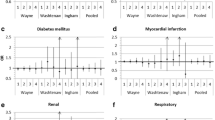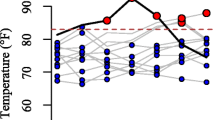Abstract
Extreme heat (EH) is a growing concern with climate change, and protecting human health requires knowledge of vulnerability factors. We evaluated whether associations between EH (maximum temperature > 97th percentile) and hospitalization for renal, heat and respiratory diseases among people > 65 years differed by individual and area-level characteristics. We used Medicare billing records, airport weather data, U.S. Census data and satellite land cover imagery in 109 US cities, May-September, 1992-2006, in a time-stratified case-crossover design. Interaction terms between EH and individual (> 78 years, black race, sex) and home ZIP-code (percentages of non-green space, high school education, housing built before 1940) characteristics were incorporated in a single model. Next, we pooled city-specific effect estimates or regressed them on quartiles of air conditioning prevalence (ACP) in a multivariate random effects meta-analysis. EH and combined renal/heat/respiratory hospitalization associations were stronger among blacks, the very old, in ZIP codes with lower educational attainment or older housing and in cities with lower ACP. For example, for EH versus non-heat days, we found a 15% (95% CI 11%-19%) increase in renal/heat/respiratory hospitalizations among individuals in ZIP codes with higher percent of older homes in contrast to a 9% (95% CI 6%-12%) increase in hospitalizations in ZIP codes with lower percent older homes. Vulnerability to EH-associated hospitalization may be influenced by age, educational attainment, housing age and ACP.


Similar content being viewed by others
References
Anderson GB, Bell ML (2009) Weather-related mortality: A study of how heat, cold, and heat waves affect mortality in the United States. Epidemiology 20(2):205–213
Basu R (2009) High ambient temperature and mortality: a review of epidemiological studies from 2001 to 2008. Environ Health 8:40
Basu R, Ostro BD (2008) A multicounty analysis identifying the populations vulnerable to mortality associated with high ambient temperature in California. Am J Epidemiol 168(6):632–637
Basu R, Pearson D, Malig B, Broadwin R, Green R (2012) The effect of high ambient temperature on emergency room visits. Epidemiology:813–820. doi:10.1097/EDE.0b013e31826b7f97
Bennefield R, Bonnette R (2003) Structural and Occupancy Characteristics of Housing: 2000. Census 2000 Brief. U.S. Department of Commerce, Economics and Statistics Administration, U.S. Census Bureau.
Bhaskaran K (2009) The effects of ambient temperature on the incidence of myocardial infarction - A systematic review. Heart:1760-9.
Bierbaum R, Smith J, Lee A, et al. (2013) A comprehensive review of climate adaptation in the United States: more than before, but less than needed. Mitig Adapt Strateg Glob Chang:361–406. doi:10.1007/s11027-012-9423-1
Bobb JF, Peng RD, Bell ML, Dominici F (2014) Heat-related mortality and adaptation to heat in the United States. Environ Health Perspect:811–816. doi:10.1289/ehp.1307392
Fletcher BA, Lin S, Fitzgerald EF, Hwang SA (2012) Association of Summer Temperatures With Hospital Admissions for Renal Diseases in New York State: A Case-Crossover Study. Am J Epidemiol:907–916. doi:10.1093/aje/kwr417
Gasparrini A, Armstrong B, Kenward MG (2012) Multivariate meta-analysis for non-linear and other multi-parameter associations. Stat Med:3821–3839. doi:10.1002/sim.5471
Geolytics I (2006) Planners package: census 2000 long form (SF3) and 1990 form in 2000 boundaries. Geolytics, Inc., East Brunswick, NJ
Gosling S, Lowe J, McGregor G, Pelling M, Malamud B (2009) Associations between elevated atmospheric temperature and human mortality: a critical review of the literature. Clim Chang 92(3):299–341
Green R, Basu R, Malig B, et al. (2010) The effect of temperature on hospital admissions in nine California counties. Int J Public Health 55(2):113–121
Greenland S, Rothman KJ, Lash TL (2008) Ch 4: measures of effect and measures of association. In: Rothman KJ, Greenland S, Lash TL (eds) Modern Epidemiology, Third edn. Lippincott Williams & Wilkins, Philadelphia, PA, pp. 51–70
Gronlund CJ (2014) Racial and socioeconomic disparities in heat-related health effects and their mechanisms: a review. Curr Epidemiol Rep. doi:10.1007/s40471-014-0014-4
Gronlund CJ, Zanobetti A, Schwartz JD, Wellenius GA, O’Neill MS (2014) Heat, heat waves and hospital admissions among the elderly in the United States, 1992–2006. Environ Health Perspect:1187–1192. doi:10.1289/ehp.1206132
Gronlund CJ, Berrocal VJ, White-Newsome JL, Conlon KC, O’Neill MS (2015) Vulnerability to extreme heat by socio-demographic characteristics and area green space among the elderly in Michigan, 1990–2007. Environ Res:449–461. doi:10.1016/j.envres.2014.08.042
Hajat S, Kosatsky T (2010) Heat-related mortality: a review and exploration of heterogeneity. J Epidemiol Community Health 64(9):753–760
Harlan SL, Declet-Barreto JH, Stefanov WL, Petitti DB (2013) Neighborhood Effects on Heat Deaths: Social and Environmental Predictors of Vulnerability in Maricopa County, Arizona. Environ Health Perspect:197–204. doi:10.1289/ehp.1104625
Hart M, Sailor D (2009) Quantifying the influence of land-use and surface characteristics on spatial variability in the urban heat island. Theor Appl Climatol:397–406. doi:10.1007/s00704-008-0017-5
IPCC (2013) Summary for policymakers. In: Stocker TF, Qin D, Plattner G-K, et al. (eds) Climate change 2013: the physical science basis contribution of Working Group I to the fifth assessment report of the intergovernmental panel on climate change. Cambridge University Press, United Kingdom
Jackson D, White IR, Thompson SG (2010) Extending DerSimonian and Laird’s methodology to perform multivariate random effects meta-analyses. Stat Med:1282–1297. doi:10.1002/sim.3602
Kirkpatrick d P, MT D (2009) Racial and sex differences in chronic obstructive pulmonary disease susceptibility, diagnosis, and treatment. Curr Opin Pulm Med:100–104. doi:10.1097/MCP.0b013e3283232825
Kloog I, Chudnovsky A, Koutrakis P, Schwartz J (2012) Temporal and spatial assessments of minimum air temperature using satellite surface temperature measurements in Massachusetts, USA. Sci Total Environ:85–92. doi:10.1016/j.scitotenv.2012.05.095
Lin S, Luo M, Walker RJ, Liu X, Hwang SA, Chinery R (2009) Extreme high temperatures and hospital admissions for respiratory and cardiovascular diseases. Epidemiology 20(5):738–746
Madrigano J, Mittleman MA, Baccarelli A, et al. (2013) Temperature, myocardial infarction, and mortality: effect modification by individual- and area-level characteristics. Epidemiology:439–446. doi:10.1097/EDE.0b013e3182878397
Medina-Ramon M, Zanobetti A, Cavanagh DP, Schwartz J (2006) Extreme temperatures and mortality: assessing effect modification by personal characteristics and specific cause of death in a multi-city case-only analysis. Environ Health Perspect 114(9):1331–1336
Medina-Ramon M, Schwartz J (2007) Temperature, temperature extremes, and mortality: a study of acclimatization and effect modification in 50 United States cities. Occup Environ Med 64(12):827–833
Morenoff JD, Lynch JW (2004) Chapter 11: What Makes a Place Healthy? Neighborhood Influences on Racial/Ethnic Disparities in Health over the Life Course. In: National Research Council (US) Panel on Race, Ethnicity, and Health in Later Life. In: Anderson N, Bulatao R, Cohen B (eds) Critical Perspectives on Racial and Ethnic Differences in Health in Late Life. National Academies Press (US),, Washington DC
Noe RS, Jin JO, Wolkin AF (2012) Exposure to natural cold and heat: hypothermia and hyperthermia Medicare claims, United States, 2004–2005. Am J Public Health:e11–e18. doi:10.2105/AJPH.2011.300557
O’Neill MS, Zanobetti A, Schwartz J (2003) Modifiers of the temperature and mortality association in seven US cities. Am J Epidemiol 157(12):1074–1082
Ostro B, Rauch S, Green R, Malig B, Basu R (2010) The effects of temperature and use of air conditioning on hospitalizations. Am J Epidemiol:1053–1061. doi:10.1093/aje/kwq231
Oswald EM, Rood RB, Zhang K, et al. (2012) An investigation into the spatial variability of near-surface air temperatures in the Detroit, MI metropolitan region. J Appl Meteorol Climatol:1290–1304. doi:10.1175/JAMC-D-11-0127.1
Pillai SK, Noe RS, Murphy MW, et al. (2014) Heat illness: predictors of hospital admissions among emergency department visits-Georgia, 2002-2008. J Community Health. doi:10.1007/s10900-013-9743-4
Rambod M, Porszasz J, Make BJ, Crapo JD, Casaburi R (2012) Six-minute walk distance predictors, including CT scan measures, in the COPDGene cohort. Chest:867–875. doi:10.1378/chest.11-0870
Rothman KJ, Greenland S, Lash TL (2008) Ch 9: validity in epidemiology studies. In: Rothman KJ, Greenland S, Lash TL (eds) Modern Epidemiology, Third edn. Lippincott Williams & Wilkins, Philadelphia, PA, pp. 128–147
Sampson N, Gronlund CJ, Buxton MA, et al. (2013) Staying cool in a changing climate: reaching vulnerable populations during heat events. Glob Environ Chang 23(2):475–484
Schwartz J (2005) Who is sensitive to extremes of temperature?: A case-only analysis. Epidemiology 16(1):67–72
Semenza JC, Rubin CH, Falter KH, et al. (1996) Heat-related deaths during the July 1995 heat wave in Chicago. N Engl J Med 335(2):84–90
Shaya FT, MS M, CM G, et al. (2009) Burden of COPD, asthma, and concomitant COPD and asthma among adults: racial disparities in a Medicaid population. Chest:405–411. doi:10.1378/chest.08-2304
Smargiassi A, Goldberg MS, Plante C, Fournier M, Baudouin Y, Kosatsky T (2009) Variation of daily warm season mortality as a function of micro-urban heat islands. J Epidemiol Commun H:659–664. doi:10.1136/jech.2008.078147
Turner LR, Barnett AG, Connell D, Tong S (2012) Ambient temperature and cardiorespiratory morbidity: a systematic review and meta-analysis. Epidemiology:594–606. doi:10.1097/EDE.0b013e3182572795
U.S. Census Bureau, Housing and Household Economic Statistics Division (2008) American Housing Survey (AHS).
Uejio CK, Wilhelmi OV, Golden JS, Mills DM, Gulino SP, Samenow JP (2011) Intra-urban societal vulnerability to extreme heat: the role of heat exposure and the built environment, socioeconomics, and neighborhood stability. Health Place:498–507. doi:10.1016/j.healthplace.2010.12.005
Vandentorren S, Croisier A, Declercq B, et al. (2006) August 2003 heat wave in France: risk factors for death of elderly people living at home. Eur J Pub Health 16(6):583–591
White-Newsome JL, McCormick S, Sampson N, et al. (2014) Strategies to reduce the harmful effects of extreme heat events: a four-city study. Int J Environ Res Public Health:1960–1988. doi:10.3390/ijerph110201960
Xu Y, Dadvand P, Barrera-Gomez J, et al. (2013) Differences on the effect of heat waves on mortality by sociodemographic and urban landscape characteristics. J Epidemiol Commun H:519–525. doi:10.1136/jech-2012-201899
Ye X, Wolff R, Yu W, Vaneckova P, Pan X, Tong S (2012) Ambient temperature and morbidity: a review of epidemiological evidence. Environ Health Perspect:19–28. doi:10.1289/ehp.1003198
Zanobetti A, MS O’N, CJ G, JD S (2013) Susceptibility to mortality in weather extremes: Assessing effect modification by zipcode area level characteristic, personal characteristics and specific cause of admission in a multi-city case-only analysis. Epidemiology:809–819. doi:10.1097/01.ede.0000434432.06765.91
Zhou W, Ji S, Chen TH, Hou Y, Zhang K (2014) The 2011 heat wave in Greater Houston: Effects of land use on temperature. Environ Res:81–87. doi:10.1016/j.envres.2014.08.025
Acknowledgments
This research was supported by the following grants: U.S. Environmental Protection Agency Science to Achieve Results Program R832752010; a National Occupational Research Agenda Pre-Doctoral Scholarship from the University of Michigan Center for Occupational Health and Safety Engineering (a National Institute for Occupational Safety and Health-funded Education and Research Center 2T42OH008455); the National Institute on Aging Interdisciplinary Research Training in Health and Aging T32AG027708; the U.S. Centers for Disease Control and Prevention EH000348, the National Institute of Environmental Health Sciences ES015774, ES024012, R21-ES020156 and R21-ES020695 and a Dow Sustainability Fellowship from the University of Michigan Graham Sustainability Institute.
Author attributions
Each author contributed to the study design; acquisition or processing of the health and/or exposure data; analysis and manuscript preparation and editing.
Author information
Authors and Affiliations
Corresponding author
Ethics declarations
The research was approved by the Institutional Review Boards at Harvard University and University of Michigan. Informed consent of subjects was waived.
Conflicts of interest
The authors declare that they have no conflicts of interest.
Electronic Supplementary Material
ESM 1
(DOCX 659 kb)
Rights and permissions
About this article
Cite this article
Gronlund, C.J., Zanobetti, A., Wellenius, G.A. et al. Vulnerability to renal, heat and respiratory hospitalizations during extreme heat among U.S. elderly. Climatic Change 136, 631–645 (2016). https://doi.org/10.1007/s10584-016-1638-9
Received:
Accepted:
Published:
Issue Date:
DOI: https://doi.org/10.1007/s10584-016-1638-9




